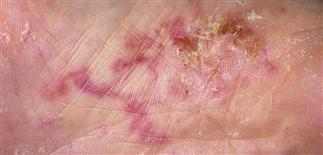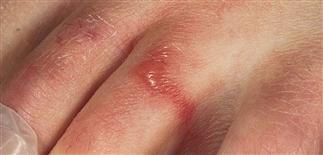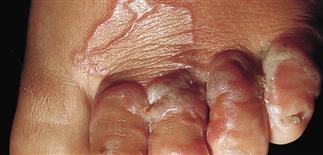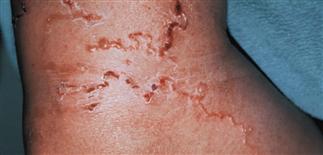98
Cutaneous larva migrans

Each day, the trapped larva struggles a few millimeters to a few centimeters laterally through the epidermis, creating a serpiginous tract.

The 1-cm larva stays concealed ahead of the advancing tip. Any skin surface can be affected but the toes and soles of the feet are most commonly affected.

During larval migration, the release of larval secretions provokes a local inflammatory response. Itching is moderate to intense. Secondary infection or eczematous inflammation occurs.

Many larvae are present in the same area, creating several closely approximated wavy lines.
DESCRIPTION
Cutaneous larva migrans (creeping eruption) is a migratory, hookworm larvae infectious condition most often seen on feet. Ancylostoma braziliense is the most common species in North America.
HISTORY
• Lesions typically begin about 3 weeks after beach vacation in the Caribbean, Africa, South America, South-East Asia, even southeastern USA. • Infection can also occur in children who play in sandboxes, carpenters and plumbers who work under houses. • Larvae are indiscriminate; parasite can penetrate skin when humans walk on moist, feces-contaminated sand. • If untreated, larvae die in 2–8 weeks, but can persist up to a year. Larvae eventually sloughed away as epidermis matures. • Typically, resolution of migration and itching occurs within 2–3 days of therapy. May take a week or so for the more intense allergic inflammatory response to resolve.
PHYSICAL FINDINGS
• Local pruritic, inflammatory eruption to the larval secretions occurs within 3 weeks of infection. Larvae cause the classic evolution into a serpiginous, red to purple lesion with a 3-mm-wide tract. • Feet and ankles most commonly involved, followed by buttocks, genitals, hands. • Itching moderate to intense; sometimes secondary infection and eczematous inflammation can occur. • Worm migrates about 2 cm daily. • Up to 30% blood eosinophil count has been reported. • Chest X-ray may show patchy infiltration.
TREATMENT
• Freezing the leading edge of the lesion with liquid nitrogen is often ineffective. • Ivermectin 200 µg/kg (average dose 12 mg) administered as a single oral dose is effective. Lesions heal within 5 days of starting ivermectin. A second round of treatment with the same dose is given for relapses. • Albendazole, either 400 mg q.d. or 200 mg b.i.d. orally for 7 days, is effective and well tolerated. Its action is rapid; pruritus disappears in 3–5 days and cutaneous lesions disappear after 6–7 days of treatment. • Thiabendazole 15% in a liquid or cream compound is applied topically three times a day for 5 days. It is applied to affected areas and 2 cm beyond the leading edge, because the parasite is often located beyond the clinical lesion. The preparation is often difficult to obtain. • Antibiotics used for secondary infection. • Topical or systemic steroids may be needed to treat severe pruritus. Typically, resolution of migration and itching occurs 2–3 days after therapy has begun. It may take a week or so for the more intense allergic inflammatory response to resolve.







